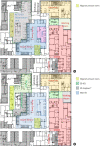Rapid deployment of an emergency department-intensive care unit for the COVID-19 pandemic
- PMID: 33440110
- PMCID: PMC7808837
- DOI: 10.15441/ceem.20.102
Rapid deployment of an emergency department-intensive care unit for the COVID-19 pandemic
Abstract
The coronavirus disease 2019 (COVID-19) pandemic mandated rapid, flexible solutions to meet the anticipated surge in both patient acuity and volume. This paper describes one institution's emergency department (ED) innovation at the center of the COVID-19 crisis, including the creation of a temporary ED-intensive care unit (ICU) and development of interdisciplinary COVID-19-specific care delivery models to care for critically ill patients. Mount Sinai Hospital, an urban quaternary academic medical center, had an existing five-bed resuscitation area insufficiently rescue due to its size and lack of negative pressure rooms. Within 1 week, the ED-based observation unit, which has four negative pressure rooms, was quickly converted into a COVID-19-specific unit, split between a 14-bed stepdown unit and a 13-bed ED-ICU unit. An increase in staffing for physicians, physician assistants, nurses, respiratory therapists, and medical technicians, as well as training in critical care protocols and procedures, was needed to ensure appropriate patient care. The transition of the ED to a COVID-19-specific unit with the inclusion of a temporary expanded ED-ICU at the beginning of the COVID-19 pandemic was a proactive solution to the growing challenges of surging patients, complexity, and extended boarding of critically ill patients in the ED. This pandemic underscores the importance of ED design innovation with flexible spacing, interdisciplinary collaborations on structure and services, and NP ventilation systems which will remain important moving forward.
Keywords: COVID-19; Emergency department; Intensive care units; Pandemics; Surge capacity.
Conflict of interest statement
No potential conflict of interest relevant to this article was reported.
Figures
Similar articles
-
Design and implementation of a temporary emergency department-intensive care unit patient care model during the COVID-19 pandemic surge.J Am Coll Emerg Physicians Open. 2020 Nov 23;1(6):1255-1260. doi: 10.1002/emp2.12323. eCollection 2020 Dec. J Am Coll Emerg Physicians Open. 2020. PMID: 33363286 Free PMC article.
-
The Mount Sinai Hospital Institute for critical care medicine response to the COVID-19 pandemic.Acute Crit Care. 2021 Aug;36(3):201-207. doi: 10.4266/acc.2021.00402. Epub 2021 Aug 10. Acute Crit Care. 2021. PMID: 34372628 Free PMC article.
-
Bench Building during COVID-19: Creating Capabilities and Training Teams.Med J (Ft Sam Houst Tex). 2021 Jan-Mar;(PB 8-21-01/02/03):79-82. Med J (Ft Sam Houst Tex). 2021. PMID: 33666916
-
The critical care literature 2022.Am J Emerg Med. 2024 Jun;80:123-131. doi: 10.1016/j.ajem.2024.03.028. Epub 2024 Apr 2. Am J Emerg Med. 2024. PMID: 38574434 Review.
-
A California Hospital's Response to COVID-19: From a Ripple to a Tsunami Warning.Crit Care Nurse. 2020 Dec 1;40(6):e1-e16. doi: 10.4037/ccn2020799. Crit Care Nurse. 2020. PMID: 32803240 Review.
Cited by
-
Outcomes for in-hospital cardiac arrest for COVID-19 patients at a rural hospital in Southern California.Am J Emerg Med. 2021 Sep;47:244-247. doi: 10.1016/j.ajem.2021.04.070. Epub 2021 Apr 27. Am J Emerg Med. 2021. PMID: 33957412 Free PMC article.
-
Endotracheal Intubation Using C-MAC Video Laryngoscope vs. Direct Laryngoscope While Wearing Personal Protective Equipment.J Pers Med. 2022 Oct 14;12(10):1720. doi: 10.3390/jpm12101720. J Pers Med. 2022. PMID: 36294859 Free PMC article.
-
Strengthening the ICUs' human resource-related responses to Covid-19: A rapid review of the experience during the first year of public health emergency.Int J Health Plann Manage. 2023 Jan;38(1):22-39. doi: 10.1002/hpm.3569. Epub 2022 Sep 27. Int J Health Plann Manage. 2023. PMID: 36164939 Free PMC article. Review.
-
Predictors of Respiratory Support Use in Emergency Department Patients With COVID-19-Related Respiratory Failure.Respir Care. 2022 Sep;67(9):1091-1099. doi: 10.4187/respcare.09772. Epub 2022 Jun 28. Respir Care. 2022. PMID: 35764346 Free PMC article. Clinical Trial.
-
The effect of COVID-19 pandemic on the length of stay and outcomes in the emergency department.Clin Exp Emerg Med. 2022 Jun;9(2):128-133. doi: 10.15441/ceem.21.058. Epub 2022 Jun 30. Clin Exp Emerg Med. 2022. PMID: 35843613 Free PMC article.
References
-
- New York State Department of Health . New York State Department of Health COVID-19 tracker [Internet] Albany, NY: New York State Department of Health; 2020. https://covid19tracker.health.ny.gov/views/NYS-COVID19-Tracker/NYSDOHCOV....
-
- Centers for Disease Control and Prevention . Overview of Testing for SARS-CoV-2 (COVID-19) [Internet] Washington, DC: US Department of Health and Human Services; 2020. https://www.cdc.gov/coronavirus/2019-ncov/hcp/clinical-criteria.html.
Grants and funding
LinkOut - more resources
Full Text Sources
Miscellaneous


